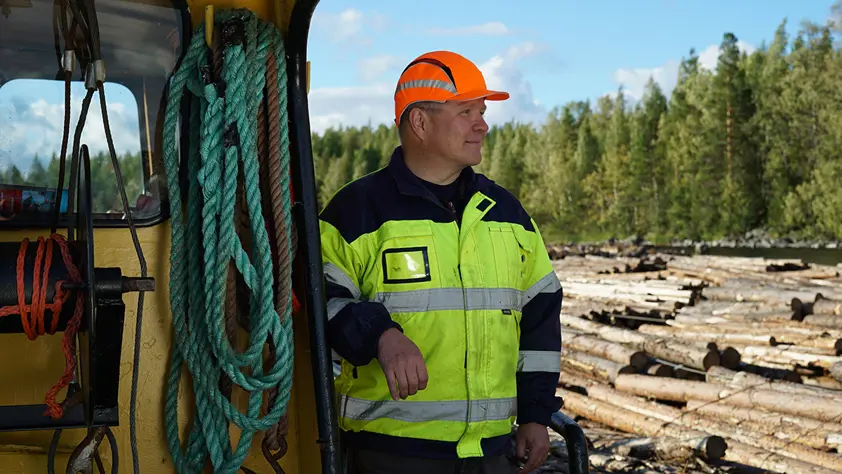In Rantasalmi, Finland, Esa Korhonen’s gaze follows the batches of logs slowly bobbing along behind the tow boat. Logistics manager for UPM Forest, and also log driving manager of the Järvi-Suomi Log Driving Association, Korhonen finds memories of his youth come flooding back.
“In Lapland in the 1970s and 80s, when log driving still took place, the logs were stored in stockpiles on the waterways which were strictly out of bounds to the public. Of course, this made it a great temptation for us youngsters and we would jump from the logs into the cold river water,” recalls Korhonen. “However, log driving hasn’t occurred since the early 1990s.”
An important form of wood transport
According to A history of log driving, log driving in Sweden began to gain popularity in the 13th and 14th centuries. Logs were also transported by rafting them along waterways in Central Europe and China in the 16th and 17th centuries. In Finland, the practice became more common in the mid-19th century, with an estimated 70,000 to 80,000 men employed in the log driving industry by 1910.
Log driving was the most important form of timber transport for the forest industry, which was built along lakes and waterways. In the golden years, up to 16 million cubic metres of logs were transported per year. However, technology, roads, cars, and railways evolved, and log trucks and trains soon replaced log driving. Today some 500,000 cubic metres of wood pass through Finnish waters per year.
While log driving activity has decreased over the decades, it is still important, explains Korhonen, for a few UPM factories such as the Pellos plywood mill in Ristiina and the Kaukas pulp mill in Lappeenranta.
“Log driving is not only a form of transport but also a form of storage, or better yet, mobile stock. When we can combine transportation and storage, log driving is a very good form of transport,” he says.
Not for amateurs
The forest industry and timber transport interested Korhonen from an early age. As a young child, he would accompany his father on log drives and to forestry work sites.
“Wood procurement, transportation and log driving flow in my blood, because in addition to my father, a few other family members worked in the forest industry. As a high school student, I was a log driver in Ounasjoki, while during my studies I was a trainee in many companies and log driving associations,” explains Korhonen.
According to Korhonen, wood procurement and the coordination of its transport is a challenging task. Consideration must be given not only to the wood needs of the customers’ industries but also to external factors.
“Weather conditions can differ vastly one year to the next, but luckily, we have different types of timber transportation available,” says Korhonen, who has worked in the forest industry for 25 years.
Korhonen became the lead log driver at the Järvi-Suomi Log Driving Association in early 2018. For him, this was a logical extension of his job at UPM as it currently the only forestry company in Finland that transports logs by means of the waterways. After all, not just anyone can drive logs and the activity is governed by its own legislation.
“When log driving is practised, it must be done so under the authority of a log driving association and supervised by a log driving manager,” emphasises Korhonen.
An eco-friendly option
While the popularity of log driving for industry may have declined from previous decades, Korhonen believes that log driving will remain a form of wood transport in Finland well into the future. There are many reasons for the recently increased interest, energy efficiency being one of them.
“The energy consumption of log driving per transported cubic metre is the lowest of the different chains. Log driving is a form of affirmative action for climate change.”
What’s more, on longer journeys of over 150 kilometres, log driving is the most cost-effective transportation option, and proves to be quite a fast way of transporting wood.
“Tens of thousands of cubic metres of logs can travel from A to B even faster than they could be transported by road,” explains Korhonen.
Keeping age-old traditions alive
While Korhonen has been interested in log driving for decades, he has not participated in log driving competitions held each summer in Finland - at least not yet.
“Log driving by itself has become tricky enough,” Korhonen says and laughs.
But now, a new generation has become enthusiastic about Finland’s log driving traditions. Timber rafting and log driving have even become a competitive sport, with national championships held in Finland each year.
Korhonen was pleased with the recent media attention Finnish youngsters interested in log driving generated. According to him, this is important to uphold both Finnish cultural traditions and log driving traditions.
“We have difficulties finding professional people with the necessary abilities and skills for demanding tasks such as log driving. This is why it’s very important to encourage young people into taking up this type of exotic profession,” sums up Korhonen.
Text: Maiju Karhunen

